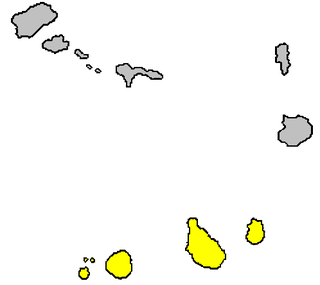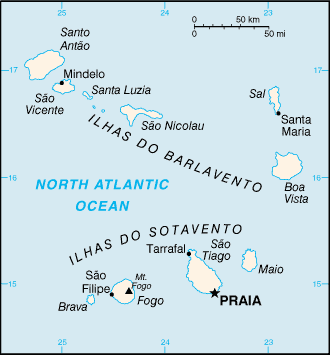
Cape Verde is a group of arid Atlantic islands which are home to distinct communities of plants, birds, and reptiles. The islands constitute the unique Cape Verde Islands dry forests ecoregion, according to the World Wildlife Fund.
Santa Luzia is Portuguese for Saint Lucia, and may refer to any of the following:

The Barlavento Islands is the northern group of the Cape Verde archipelago. It presents as two sub-groups:

Santa Luzia is an island of the Barlavento archipelago in Cape Verde located between São Nicolau and São Vicente, the channel of Santa Luzia separates the island of São Vicente and is 8 km wide. The area is 34.2 km². Like all Cape Verdean islands, it is of volcanic origin. The highest point is Topona. Santa Luzia is 12.4 km long and 5.3 km wide.

São Nicolau is one of the Barlavento (Windward) islands of Cape Verde. It is located between the islands of Santa Luzia and Sal. Its population is 12,424 (2015), with an area of 343 km2 (132 sq mi). The main towns are Ribeira Brava and Tarrafal de São Nicolau.

The Sotavento Islands is the southern island group of the Cape Verde archipelago. There are four main islands. The western three islands, Brava, Fogo and Santiago, are rocky and volcanic agricultural islands, with the longest histories of human habitation. The fourth and easternmost island Maio is a flat desert island whose economy was primarily based on salt, giving it more in common with the Barlavento islands Sal and Boa Vista. The Ilhéus do Rombo are barren islets north of Brava. The total area of the Sotavento Islands is 1,803 km2 (696 sq mi).

Ilhéu Raso is an uninhabited 5.76 square kilometres volcanic island in the Barlavento archipelago of Cape Verde. It is flanked by the smaller Branco islet to the west and by São Nicolau island on its eastern side, distance is 15 kilometres from the island of São Nicolau. Together with Santa Luzia and Ilhéu Branco, Ilhéu Raso is on the tentative list of UNESCO's World Heritage Sites. Since 1990, the islet is part of the protected area Reserva Natural Integral de Santa Luzia.

Ilhéu Branco is an uninhabited 278-hectare (690-acre) islet in the Barlavento group of the Cape Verde archipelago off the coast of north-west Africa in the Atlantic Ocean. Ilhéu Branco is flanked by the islands of Santa Luzia to the north-west and Ilhéu Raso to the south-east. Since 1990, the islet is part of the protected area Reserva Natural Integral de Santa Luzia. Together with Santa Luzia and Ilhéu Raso, Ilhéu Branco is on the tentative list of UNESCO's World Heritage Sites.

The Cape Verde Islands dry forests is a tropical and subtropical dry broadleaf forests ecoregion in the Cape Verde Islands, which constitute the country of Cabo Verde. The islands lie off the western coast of Africa.
The Cape Verdean Football Championship or the Campeonato Caboverdiano de Futebol is a football competition that was created in 1976 in Cape Verde. A local championship was founded in 1953 before independence, when the islands were still part of the Portuguese Empire.

The territory of Cape Verde is divided into 22 concelhos (municipalities), and subdivided into 32 freguesias.

The wildlife of Cape Verde is spread over its archipelago of ten islands and three islets, which all have parks under their jurisdiction by decree promulgated by the Cape Verde government. Located off the west coast of Africa, the total land area of the island nation is 4,564 square kilometres (1,762 sq mi). The wildlife consists of many tropical dry forest and shrub land, endemic flora and fauna, and rare breeding seabirds and plants, which are unique to this group of islands.
The license plates in Cape Verde have been derived from the former colonial power Portugal.
The Diocese of Santiago de Cabo Verde is a Latin Church ecclesiastical territory or diocese of the Catholic Church in Cape Verde. It covers the islands of Maio, Santiago, Fogo, and Brava. Its cathedra is within the Pró-catedral Nossa Senhora da Graça in Praia, Santiago. The diocese is immediately exempt to the Holy See and is not part of any ecclesiastical province.
Cape Verde is an archipelago, and its islands are historically divided into two groups, or regions:

Echium stenosiphon is a plant species of the family Boraginaceae. The species is endemic to Cape Verde. Its local name is língua-de-vaca, a name that may also refer to the related species Echium vulcanorum and Echium hypertropicum. The plant is used in traditional medicinal for a cough syrup.
The Culture of the Island of São Vicente, Cape Verde is the second richest in the nation, with a range of customs and practices common in the islands,

The island of Fogo in Cape Verde in the westcenter of the Sotavento Islands is home to several teams and clubs. The major professional clubs is Botafogo, semi-pro teams includes Académica do Fogo and Vulcânicos, the remainder including the youth club Juventude and Spartak d'Aguadinha are amateur. The football competition was the third along with Sal to have its own first held in 1976 after the nation's independence. From its foundation to 2005, the island had a single league of each sport, it is currently divided into two divisions, the Premier and the Second.
This page is based on this
Wikipedia article Text is available under the
CC BY-SA 4.0 license; additional terms may apply.
Images, videos and audio are available under their respective licenses.












